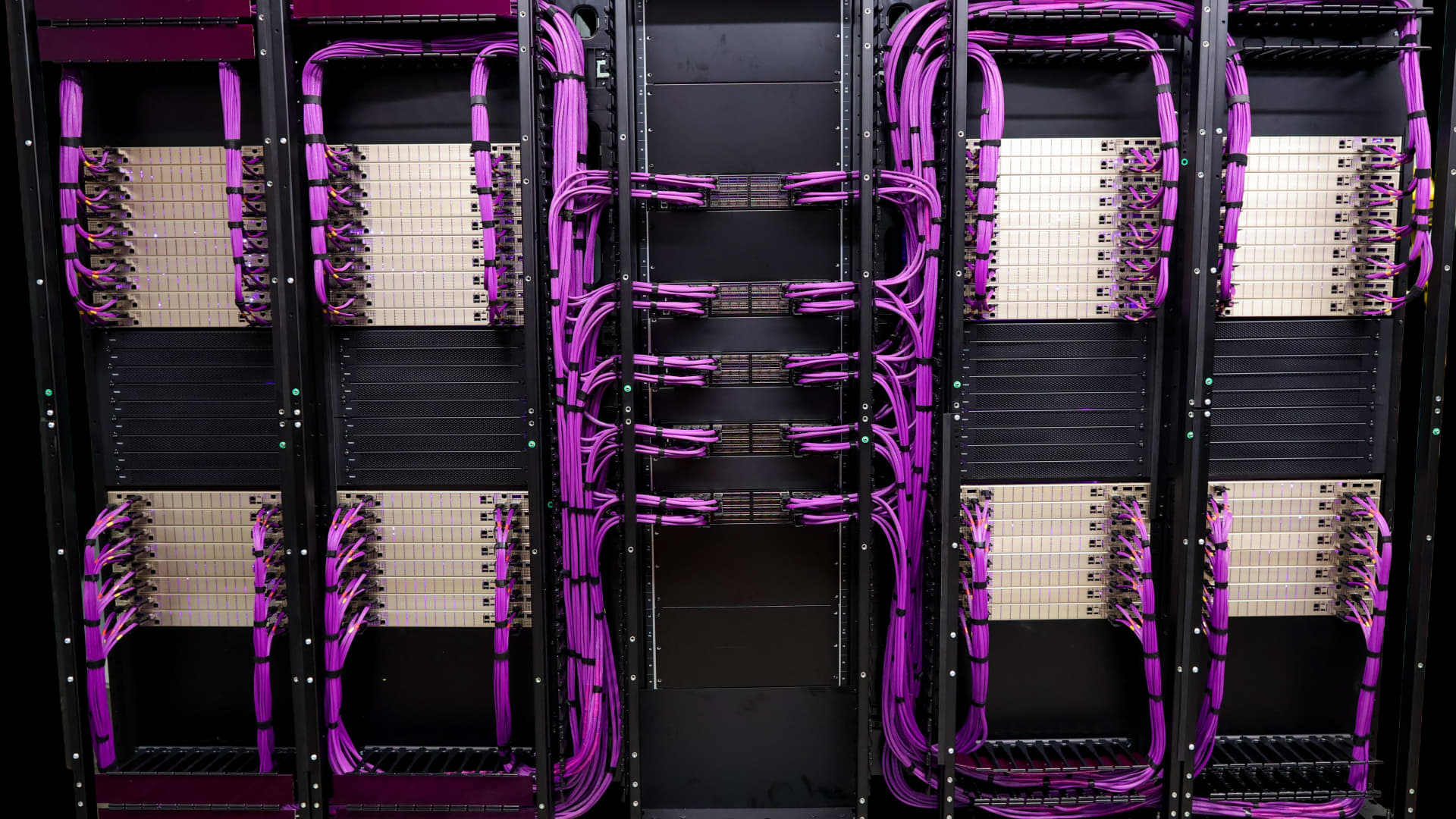A demo setup of racks of AI servers connected with Credo cables, displayed at the Open Compute Summit in San Jose, California.
Credo
In July, Elon Musk posted photos from inside an xAI data center called Colossus 2, which the artificial intelligence startup aims to turn into a massive supercomputing facility in Memphis, Tennessee.
Musk’s pictures, posted to his X feed, didn’t show off the pricey Nvidia racks that are filled with powerful graphics processing units. Rather, he focused on the wires behind the servers, including one image with thousands of neatly organized purple cables connecting the computers together.
Those purple cables are the signature offering of Credo, a 17-year-old Silicon Valley-based semiconductor company whose name rarely gets mentioned alongside the leaders of the AI boom.
But Wall Street has taken notice.
Credo shares have more than doubled this year to $143.61 after soaring 245% in 2024. The company’s market cap, which was about $1.4 billion at the time of its IPO in 2022, now sits at close to $25 billion. Credo is angling to position itself as a key supplier in the trillion-dollar AI infrastructure expansion, and is benefiting as the money flows downstream.
The stock jumped 5% on Friday after analysts at JPMorgan Chase initiated coverage with the equivalent of a buy rating and a $165 stock price. They said the active electrical cable (AEC) market, which Credo pioneered, is on pace to hit $4 billion by 2028, as all the major hyperscalers invest in data center buildouts.
“The industry outlook is supported by increasing deployments from major companies such as Amazon, Microsoft, and xAI as well as broadening adoption, including Meta and more,” the analysts wrote. They predict annualized revenue growth for Credo of at least 50% through 2028.

Revenue in fiscal 2025, which ended in early May, more than doubled to $436.8 million. The company also turned profitable, recording net income of $52.2 million after losing $28.4 million the prior year. Analysts are expecting sales to more than double again in fiscal 2026 to almost $1 billion, according to LSEG.
Credo’s purple AECs cost between $300 and $500 each, depending on bulk discounts and other negotiations, according to an estimate from the 650 Group, an industry researcher. They are sturdy, moderately thick copper cables wrapped in a braided covering with big connectors containing chips on each side.
Much of the excitement around Credo is driven by the AI boom, which to this point has been driven by a handful of hyperscalers that are rapidly building data centers for future expected workloads. Analysts expect $1 trillion in spending on AI data centers by 2030, but any pullback from the major cloud providers or scaling back in OpenAI’s plans could hurt many suppliers, including Credo.
For now, projections are way up and to the right.
Expanding opportunity
Previous servers typically had one or two processors on a motherboard. Individual servers today can have up to eight, and the most powerful AI models require potentially millions of GPUs all working together as one.
Each GPU needs its own connection to the switch, the term for a computer that routes data around the cluster, often mounted on the top of a server rack.
Nvidia’s latest products slot several of these boards together to comprise a system with 72 GPUs. Next year’s fastest racks will have twice as many, and the following year, a Kyber rack will have 572 GPUs, Nvidia says.
“In the past, Credo’s opportunity was one cable per server, but now Credo’s opportunity is nine cables per server,” said Alan Weckel, an analyst at 650 Group. He estimates that Credo has 88% of the market for AECs, which are also made by Astera Labs and Marvell.
Many GPUs are connected by fiber optic cables powered by components made by companies like Broadcom and Coherent. AECs offer an alternative to fiber optic cables. They have chips called digital signal processors on both sides that use sophisticated algorithms to pull data out of the cable, enabling much longer lengths than traditional copper cables. Credo’s longest AEC is seven meters long.
Credo CEO Bill Brennan, who joined the company in 2013, told CNBC that hyperscalers are choosing his company’s cables because they’re more reliable than fiber optic cables. He said customers are trying to avoid what’s called a “link flap,” where one part of an AI cluster goes offline because the optical cable connecting them fails, costing hours of pricey GPU time.
“It can literally shut down an entire data center,” Brennan said.
He said Credo is increasingly working with hyperscalers in the early stages of planning large AI clusters, especially as some designs become denser, allowing more servers to be connected by shorter cables.
“When you connect with these hyperscalers, the numbers are very large,” Brennan said.
Credo’s AEC leadership team, Hal Hawthorne, Don Barnetson, Ameet Suri, and Ryan Cai.
Corey Bentley, Credo
The company doesn’t name its hyperscaler clients, but analysts have cited Amazon and Microsoft as customers. Amazon Web Services CEO Matt Garman posted an image on LinkedIn of the company’s Trainium AI chip racks on Friday that appeared to show Credo’s purple cables.
Credo says it expects three or four customers to make up more than 10% of revenue each in the coming quarters, including two new hyperscale customers this year.
Amazon and Microsoft declined to comment. Meta and xAI didn’t respond to requests for comment.
At a conference for data center professionals in San Jose this week, Credo presented alongside a representative from Oracle Cloud. An example rack of Nvidia GPUs designed by Meta displayed at the show prominently featured Credo’s purple cables.
“Every time you see a new announcement of a gigawatt data center, you can rest assured that we view that as an opportunity,” Brennan told investors on an earnings call in September.
It’s a market that everyone in AI networking is targeting.
Analysts at TD Cowen estimated earlier this month that the market for AI networking chips could be worth $75 billion per year by 2030. Major players include Nvidia and Advanced Micro Devices, which both have their own networking businesses and have the power to dictate which technologies are part of their broader systems.
‘Insatiable demand’
Credo was founded in 2008 by a group of ex-Marvell engineers, who developed chips for a relatively arcane technology called SerDes, which is used for high-speed chip-to-chip connections.
Brennan’s job, when he joined in 2013, was to commercialize the technology. The company raised its first round of venture funding in 2015 from investors including Walden International, which was run by Lip-Bu Tan, now Intel’s CEO.
The AEC business didn’t take off until the AI boom in the early 2020s, because data centers didn’t yet need its technology, Brennan said.
However, there was early excitement in the air when Musk’s car company came knocking in 2017. Tesla wanted help with its Dojo AI supercomputer and needed chips with more bandwidth than what was available at the time.
Now, Credo is hoping to use its foothold with its active copper cables to branch out into additional product lines, including intra-rack connections, or what’s called “scale-up” networking. The company announced new transceivers and software for optical cables this week.
“You’ve got this market pull like we’ve never had before,” Brennan said. “If you could deliver the next generation right now, it would be consumed. Generation after that, it would be consumed. You’ve got this insatiable demand from the AI cluster world.”
WATCH: OpenAI in Abilene, Texas






